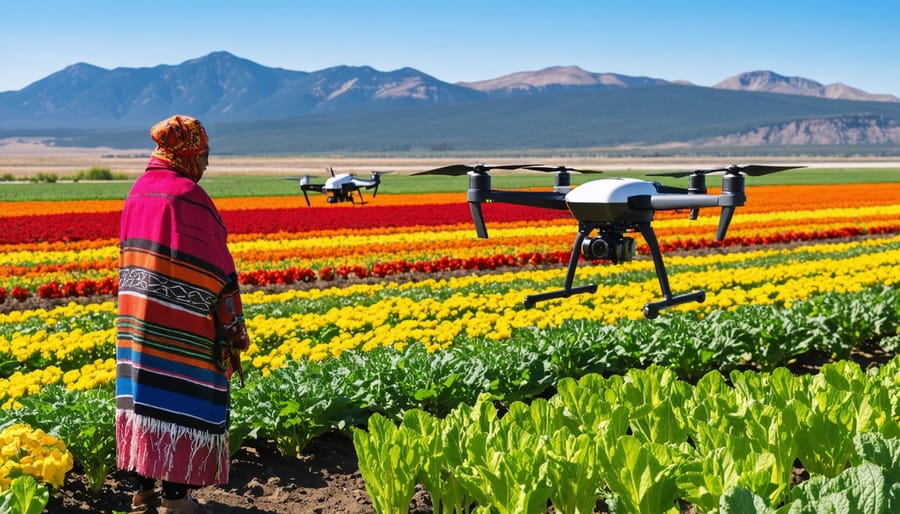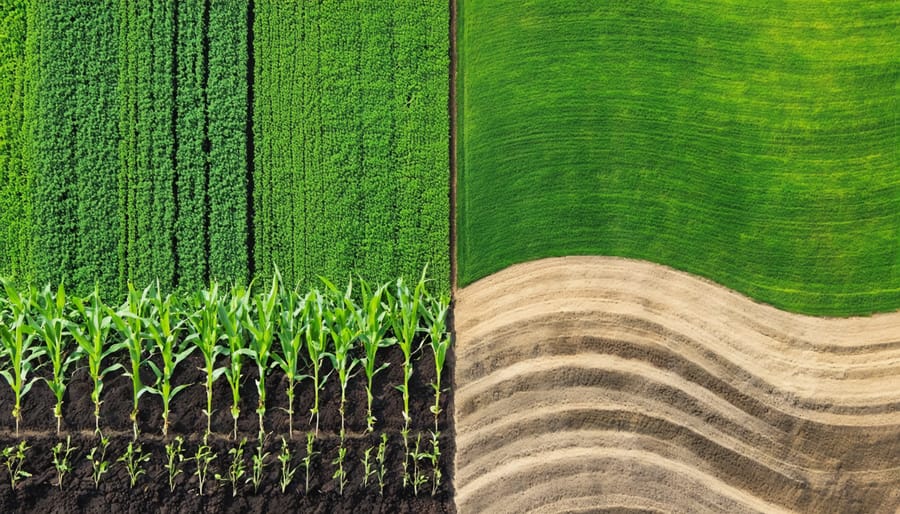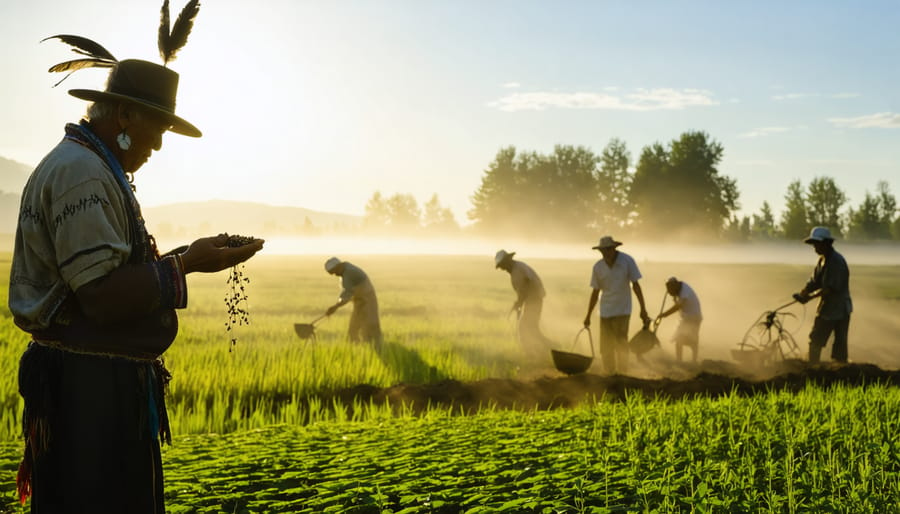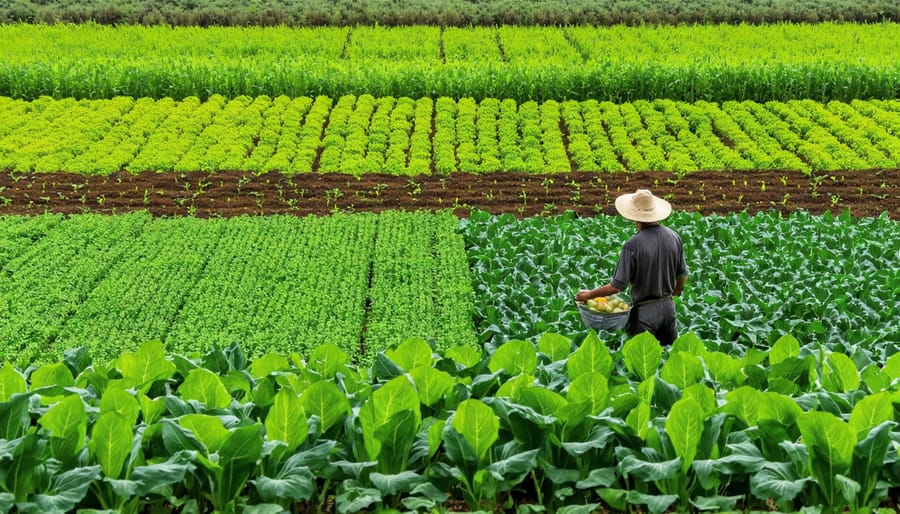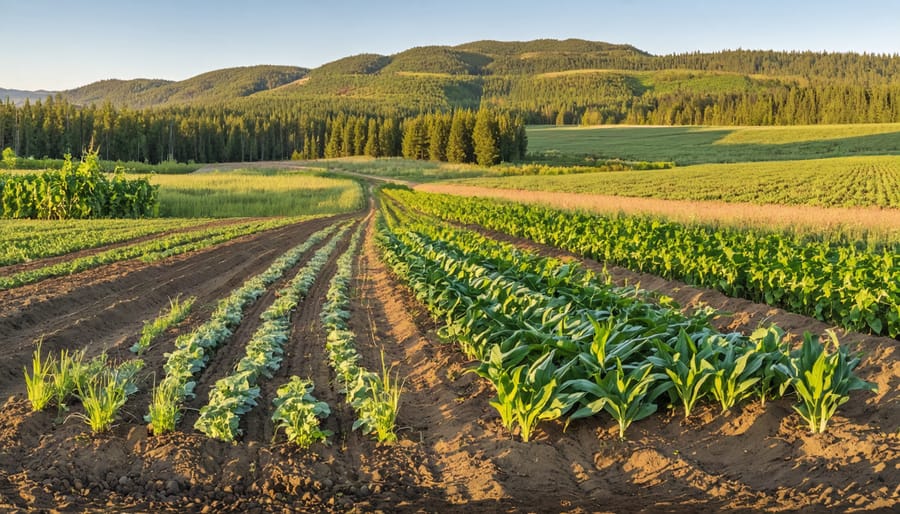Optimize every drop of agricultural water through precision irrigation scheduling, soil moisture monitoring, and advanced weather data integration. Modern water management merges time-tested indigenous permaculture principles with cutting-edge technology, reducing water consumption by up to 30% while maintaining crop yields. Alberta farmers currently save 55 billion litres annually through strategic water management, demonstrating the profound impact of smart irrigation practices.
Drought-resistant crop selection, companion planting, and innovative soil amendment techniques now form the foundation of sustainable water management across the Canadian prairies. These practices, combined with precision agriculture technology, have helped local farmers reduce irrigation costs by an average of $75 per hectare while improving soil health and crop resilience.
By integrating traditional knowledge with modern conservation methods, Prairie producers are revolutionizing agricultural water use. Real-time soil moisture sensors, weather-based irrigation scheduling, and water-efficient crop varieties work together to create resilient farming systems that protect our most precious resource while maintaining profitable operations.
Traditional Indigenous Water Management: A Canadian Heritage
First Nations Water Conservation Methods
First Nations communities across Alberta have long practiced sophisticated water conservation methods that continue to inform traditional farming wisdom today. The Three Sisters planting method, where corn, beans, and squash are grown together, creates natural moisture retention through ground cover and reduces water consumption by up to 30% compared to single-crop plantings.
Indigenous water management techniques include the use of natural swales and berms to direct and preserve snowmelt, a practice particularly effective in Alberta’s climate. These earthworks, strategically placed along contour lines, can retain up to 75% more moisture in the soil throughout the growing season.
Many First Nations farmers also employ companion planting with drought-resistant native species like yarrow and sage, which act as natural mulch and help retain soil moisture. The practice of timing plantings with natural precipitation cycles, rather than forcing rigid growing schedules, results in more efficient water use and healthier crops.
Modern farmers are increasingly adopting these time-tested methods, often combining them with current technology to create sustainable, water-wise farming systems that honor indigenous knowledge while meeting contemporary agricultural needs.
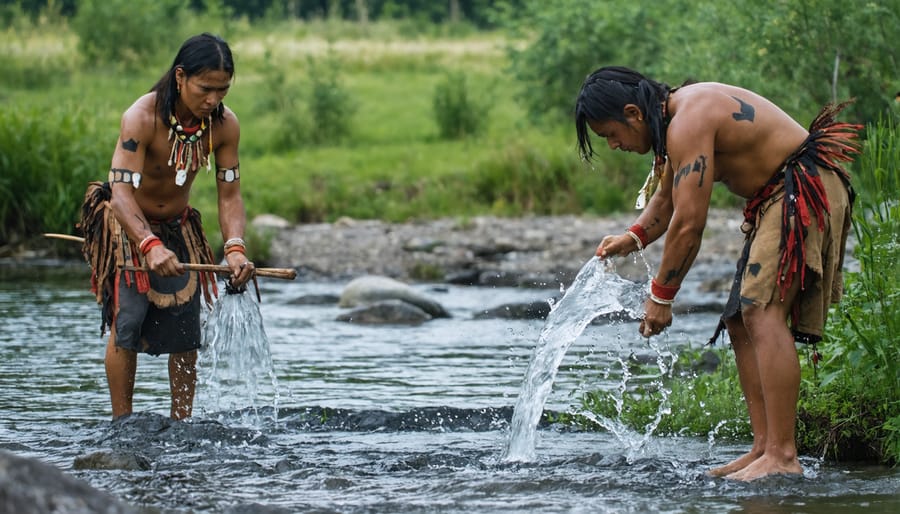
Seasonal Water Harvesting Traditions
In Alberta’s agricultural communities, seasonal water harvesting has deep roots in both indigenous wisdom and settler practices. Traditional methods typically begin in early spring, with the collection of snowmelt through strategically placed catch basins and natural depressions in the landscape. Many farmers time their water collection efforts with the spring thaw, usually occurring between March and April, when runoff volumes are at their peak.
Summer harvesting focuses on rainfall collection, with many farmers using a combination of retention ponds and cisterns. These systems are often designed to capture water during the region’s wettest months, typically June and July, storing it for use during the drier late summer period.
Fall preparation is crucial, with many agricultural operations conducting maintenance on their collection systems before winter. This includes clearing drainage channels, reinforcing pond banks, and ensuring storage systems are properly sealed. Some farmers also incorporate traditional indigenous techniques, such as creating small berms and swales to direct and slow water flow across their land.
Many successful operations combine these seasonal practices with modern monitoring systems, allowing for precise timing of collection efforts based on weather forecasts and soil moisture levels.
Modern Applications of Indigenous Techniques
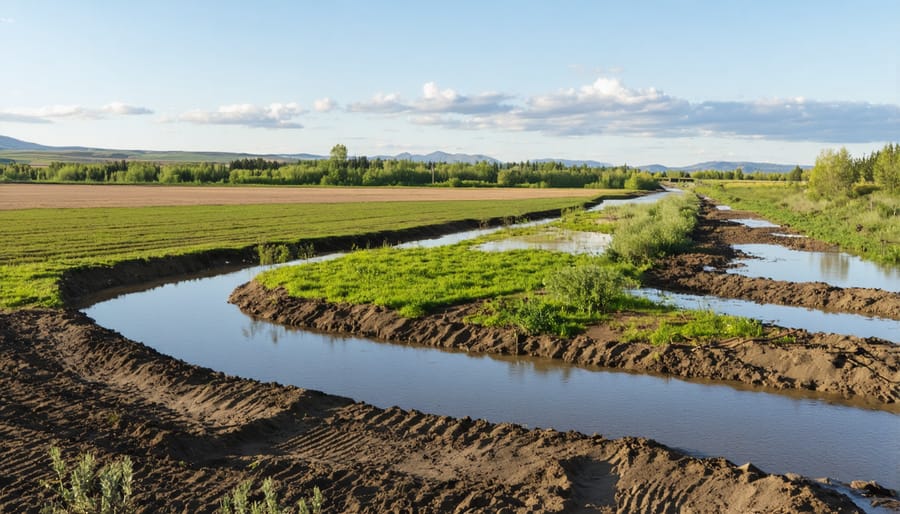
Natural Water Retention Systems
Modern farmers are increasingly turning to sustainable agricultural practices by implementing natural water retention systems that combine traditional wisdom with contemporary materials. These systems help maintain soil moisture while reducing irrigation needs and protecting against both drought and flooding.
Key to these systems are strategically placed retention ponds, which can be lined with modern geotextile materials to prevent seepage while maintaining natural filtration. Many Alberta farmers have successfully implemented these ponds, typically sizing them at 500-1000 cubic metres per 40 hectares of farmland.
Swales and berms, constructed using GPS-guided equipment, create natural water highways across the landscape. These gentle slopes, typically 1-2 metres wide and 30-50 centimetres deep, slow water movement and encourage ground absorption. Modern laser leveling ensures optimal gradient for water distribution.
Cover crops play a crucial role in water retention. Species like fall rye and clover create root systems that improve soil structure and water-holding capacity. When combined with minimal tillage practices, these crops can increase soil moisture retention by up to 25%.
Mulching with locally available materials like straw or wood chips helps reduce evaporation. Modern spreaders can efficiently distribute mulch at optimal depths of 5-10 centimetres. Some farmers are experimenting with biodegradable agricultural films that provide similar benefits while breaking down naturally.
For best results, integrate these systems with soil moisture monitoring technology. Simple soil probes or more advanced IoT sensors can help track water levels and optimize retention strategies throughout the growing season. This combination of traditional methods and modern tools creates resilient water management systems that work with nature rather than against it.
Drought-Resistant Field Design
In Alberta’s diverse agricultural landscape, traditional indigenous field design principles offer valuable insights for modern drought resistance. The Blackfoot and Cree peoples historically used natural landforms and vegetation patterns to maximize water retention, techniques that continue to prove effective today.
One key approach is the implementation of contour farming, where field layouts follow the natural curves of the land. This method, inspired by indigenous practices, reduces water runoff by up to 30% compared to conventional straight-row planting. Calgary farmer Mike Thompson incorporated these principles on his 200-hectare farm, resulting in a 25% reduction in irrigation needs during the 2022 growing season.
Indigenous knowledge also emphasizes the importance of windbreaks and natural barriers. Strategic placement of trees and shrubs along field edges helps reduce evaporation and protect soil moisture. The Farming Smarter research station in Lethbridge found that fields with natural windbreaks retained soil moisture for an average of 12 days longer during dry spells.
Consider integrating these design elements:
– Terraced fields on sloping land to capture and slow water movement
– Small depressions or micro-basins to collect rainfall
– Native grass buffer strips between crops
– East-west row orientation to minimize evaporation
Local farmer Sarah Running Deer combines these traditional approaches with modern precision agriculture on her family farm near Red Deer. “Our ancestors understood the importance of working with the land rather than against it,” she explains. “By incorporating these time-tested design principles with current technology, we’ve created resilient fields that perform well even in drought conditions.”
Remember that field design modifications can be implemented gradually, allowing for adaptation and learning from results over multiple growing seasons.
Case Study: Success Stories from Alberta
The Thompson Family Farm Revolution
In 2018, the Thompson family, fourth-generation farmers near Lethbridge, Alberta, embarked on a transformative journey that would reshape their 2,000-hectare operation. Working closely with local Indigenous elders from the Blackfoot community, they discovered that traditional water management techniques could be successfully integrated with modern farming practices.
Sarah Thompson, the farm’s current manager, implemented a system of shallow retention basins inspired by Indigenous agricultural methods, combined with soil moisture monitoring technology. “We learned that our ancestors on this land had sophisticated ways of preserving water,” explains Thompson. “By adapting these principles to our current operation, we’ve seen remarkable results.”
The family installed a network of micro-catchments across their fields, allowing rainwater to slowly percolate into the soil rather than running off. They also introduced drought-resistant crop varieties traditionally used by Indigenous peoples and adjusted their planting patterns to maximize natural water retention.
The results were impressive: water consumption dropped by 40% within two years, while crop yields remained stable. Annual irrigation costs decreased by $45,000, and soil health indicators improved significantly. The Thompsons now host monthly workshops for local farmers, sharing their experience and promoting sustainable water management practices.
“It’s about understanding the land and working with it, not against it,” Sarah reflects. “These traditional techniques, combined with modern technology, have made our farm more resilient and sustainable for the next generation.”
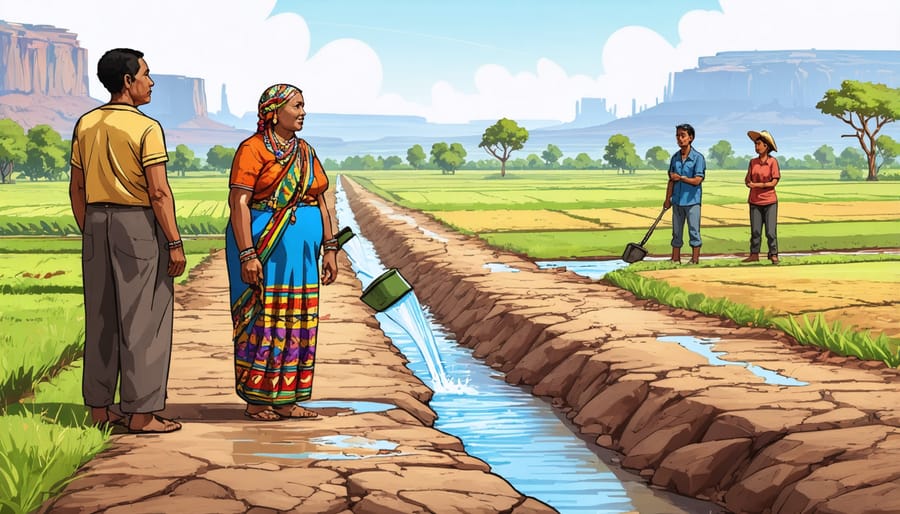
Community Water Sharing Initiative
In the heart of Alberta’s Wheatland County, a remarkable water-sharing initiative has taken root, drawing inspiration from traditional Indigenous water stewardship practices. The Three Rivers Collaborative, established in 2019, brings together 24 farming families who collectively manage their water resources through a system of shared reservoirs and irrigation schedules.
The project began when local farmer Sarah Thompson noticed how traditional Indigenous methods of water management emphasized community cooperation over individual usage. Working with Elder Robert Crowfoot from the Siksika Nation, the group developed a framework that combines modern irrigation technology with time-tested principles of resource sharing.
The system operates on a rotating schedule, where farmers coordinate their irrigation timing based on crop needs and seasonal conditions. During the 2021 drought, this collaborative approach helped participating farms maintain crop yields 30% higher than the regional average, while using 20% less water overall.
“What makes this initiative special is how it’s brought our community together,” explains Thompson. “We’re not just sharing water – we’re sharing knowledge, equipment, and support.” The group meets monthly to adjust their water management strategy, using data from soil moisture sensors and weather forecasts to make informed decisions.
The success of the Three Rivers Collaborative has inspired similar initiatives across Alberta, demonstrating how traditional wisdom and modern farming can work together to create sustainable water management solutions.
Implementation Guide for Your Farm
Assessment and Planning
Effective water management begins with a thorough assessment of your farm’s unique characteristics and requirements. Start by mapping your property’s water sources, including wells, streams, and rainfall patterns. Consider implementing modern indigenous farming techniques that have proven successful in Alberta’s diverse climate conditions.
Create a water audit by documenting current usage patterns across different seasons. Track irrigation schedules, livestock consumption, and crop requirements in metric measurements. For most Alberta farms, peak water demand occurs during the growing season, typically from May to September.
Develop your implementation strategy by:
– Calculating total water requirements per hectare
– Identifying potential water-saving opportunities
– Setting realistic conservation targets
– Establishing monitoring systems
– Planning for drought conditions
Consider working with local agricultural extension services to conduct soil moisture testing and determine optimal irrigation scheduling. Many successful Alberta farmers use soil moisture sensors and weather monitoring systems to fine-tune their water management strategies.
Remember to account for future expansion plans and climate variability. Build flexibility into your strategy by incorporating multiple water sources and storage options. Regular review and adjustment of your plan ensure it remains effective as your operation evolves and environmental conditions change.
Partner with neighbouring farmers to share resources and knowledge, creating a community-based approach to water management that benefits everyone.
Resources and Support
Alberta farmers have access to numerous resources and support systems to help implement effective water management strategies. The Alberta Irrigation Districts Association (AIDA) offers comprehensive guidance, technical support, and funding opportunities specifically designed for local agricultural operations. Their irrigation management workshops run throughout the growing season in various locations across the province.
For hands-on assistance, Agricultural Service Boards (ASBs) in your county can provide personalized consultations and connect you with local water management experts. The Alberta Agriculture and Irrigation Ministry maintains a network of extension specialists who offer free technical advice and can help you develop customized water management plans.
Financial support is available through various programs, including the Canadian Agricultural Partnership (CAP) grants, which can cover up to 70% of costs for irrigation system upgrades and water conservation projects. The Environmental Farm Plan (EFP) program provides additional funding opportunities while helping you assess your farm’s environmental impact.
For ongoing learning, join the Alberta Water Portal Society’s online community, where you can connect with other farmers, share experiences, and access the latest research on agricultural water management. The University of Alberta’s Faculty of Agricultural, Life & Environmental Sciences regularly hosts webinars and workshops on sustainable water practices.
Remember to reach out to your local Indigenous communities and knowledge keepers, who often partner with agricultural organizations to share traditional water management wisdom that has proven effective in our region for generations.
As we look to the future of agriculture in Alberta, it’s clear that the most effective approach to water management lies in harmoniously blending time-tested traditional practices with modern innovations. Our First Nations communities have long understood the delicate balance between land, water, and crop cultivation, demonstrating sustainable practices that have endured for generations. These teachings, combined with today’s advanced irrigation systems and precision agriculture technologies, create a powerful framework for responsible water stewardship.
The success stories we’ve seen across Alberta’s farmlands demonstrate that farmers who embrace both traditional wisdom and contemporary methods often achieve better yields while using less water. Whether it’s implementing traditional companion planting techniques alongside moisture sensors, or combining indigenous drought-resistant crop varieties with modern drip irrigation, the possibilities for innovation are endless.
As our climate continues to change and water becomes an increasingly precious resource, this integrated approach becomes not just beneficial, but essential. By respecting and learning from traditional knowledge while embracing technological advances, we can build resilient farming operations that sustain both our communities and our environment.
The future of sustainable agriculture in Alberta depends on our willingness to learn from the past while innovating for tomorrow. Together, as a farming community, we can ensure that our water resources are managed wisely for generations to come.


